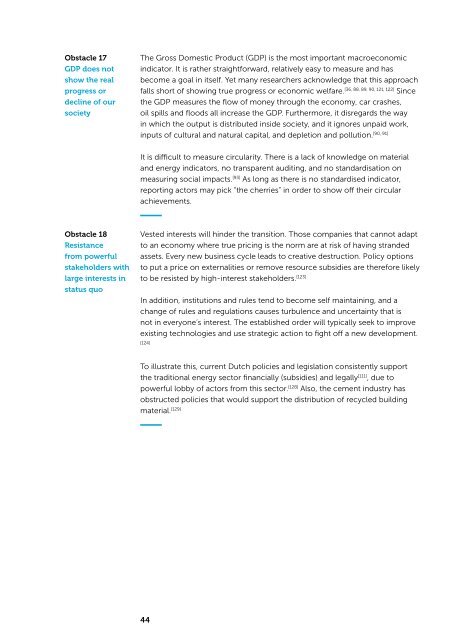Unleashing the Power of the Circular Economy
Unleashing the Power of the Circular Economy
Unleashing the Power of the Circular Economy
Create successful ePaper yourself
Turn your PDF publications into a flip-book with our unique Google optimized e-Paper software.
Obstacle 17<br />
GDP does not<br />
show <strong>the</strong> real<br />
progress or<br />
decline <strong>of</strong> our<br />
society<br />
Obstacle 18<br />
Resistance<br />
from powerful<br />
stakeholders with<br />
large interests in<br />
status quo<br />
The Gross Domestic Product (GDP) is <strong>the</strong> most important macroeconomic<br />
indicator. It is ra<strong>the</strong>r straightforward, relatively easy to measure and has<br />
become a goal in itself. Yet many researchers acknowledge that this approach<br />
falls short <strong>of</strong> showing true progress or economic welfare. [36, 88, 89, 90, 121, 122] Since<br />
<strong>the</strong> GDP measures <strong>the</strong> flow <strong>of</strong> money through <strong>the</strong> economy, car crashes,<br />
oil spills and floods all increase <strong>the</strong> GDP. Fur<strong>the</strong>rmore, it disregards <strong>the</strong> way<br />
in which <strong>the</strong> output is distributed inside society, and it ignores unpaid work,<br />
[90, 91]<br />
inputs <strong>of</strong> cultural and natural capital, and depletion and pollution.<br />
It is difficult to measure circularity. There is a lack <strong>of</strong> knowledge on material<br />
and energy indicators, no transparent auditing, and no standardisation on<br />
measuring social impacts. [93] As long as <strong>the</strong>re is no standardised indicator,<br />
reporting actors may pick “<strong>the</strong> cherries” in order to show <strong>of</strong>f <strong>the</strong>ir circular<br />
achievements.<br />
Vested interests will hinder <strong>the</strong> transition. Those companies that cannot adapt<br />
to an economy where true pricing is <strong>the</strong> norm are at risk <strong>of</strong> having stranded<br />
assets. Every new business cycle leads to creative destruction. Policy options<br />
to put a price on externalities or remove resource subsidies are <strong>the</strong>refore likely<br />
to be resisted by high-interest stakeholders. [123]<br />
In addition, institutions and rules tend to become self maintaining, and a<br />
change <strong>of</strong> rules and regulations causes turbulence and uncertainty that is<br />
not in everyone’s interest. The established order will typically seek to improve<br />
existing technologies and use strategic action to fight <strong>of</strong>f a new development.<br />
[124]<br />
To illustrate this, current Dutch policies and legislation consistently support<br />
<strong>the</strong> traditional energy sector financially (subsidies) and legally [111] , due to<br />
powerful lobby <strong>of</strong> actors from this sector. [128] Also, <strong>the</strong> cement industry has<br />
obstructed policies that would support <strong>the</strong> distribution <strong>of</strong> recycled building<br />
material. [129]<br />
44



